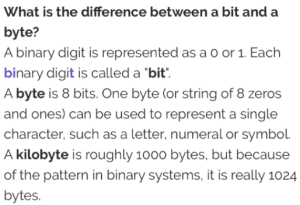Difference between Bit and Byte in tabular form

It is very common to confuse the terms bit and byte, however, their almost daily use today forces us to know their differences. The Basic difference between Bit and Byte is that Bit is a binary digit 0 or 1, while Byte is a set of 8 bits. Furthermore differences between Bits and Bytes given in the post below.
Keep reading
Bit
The bit is an acronym for the term Binary digit, that is, it is a binary digit. It is a digit of the binary numbering system. The storage capacity of digital memory is also measured in bits.
While in the decimal numbering system 10 digits are used, in the binary only 0 and 1 are used.
It is the minimum unit of information used in computing and allows us to represent any two values, be it true or false, black or white, open or closed. Since only two states can be represented, bit combinations are used to achieve more information.
Byte
A byte is the base information unit used in communication and telecommunications and is equivalent to an ordered set of bits, usually 8 bits, which is why it is known as an octet in Spanish.
It does not have an internationally established symbol, but it is usually represented as B in Anglo-Saxon countries while in countries influenced by French they use the O for octet.
It is the smallest amount of data that a computer can “bite into” at one time.
Differences between bit and byte
- A byte is the smallest unit of data that a computer can record. It is also a continuous sequence of bits in a serial data stream as in telecommunications. Bytes include start, stop, parity bits, and can contain up to 12 bits.
- A bit is a digit that represents the binary numbering system. A bit can be 0 or 1 and is often used to define it, the analogy “off” and “on” is the minimum unit of information for computing.